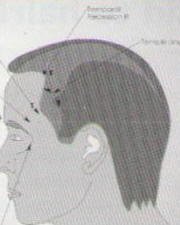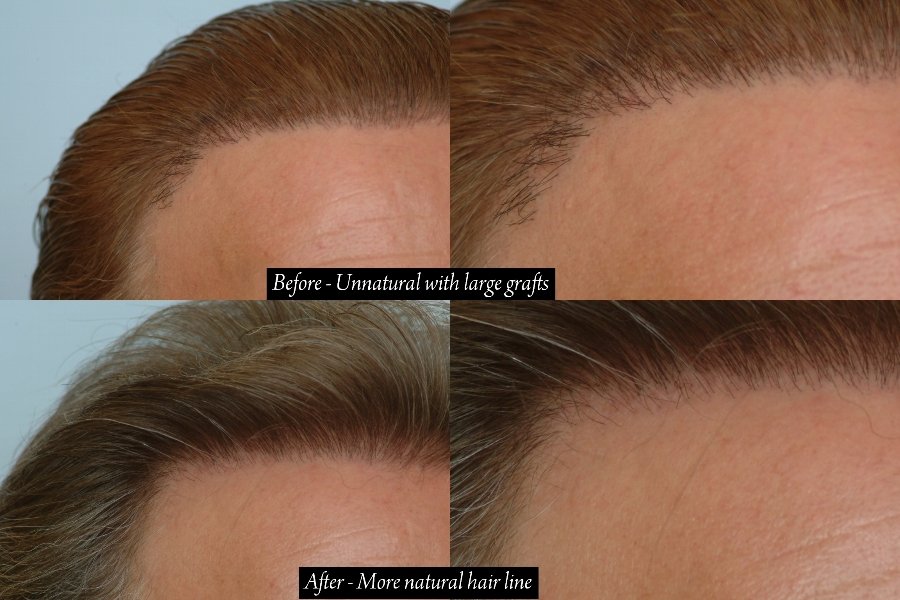» Very natural! Not all guys can look like this patient,just think about we
» who have naturally high hairlines. Look at his peak! It can’t get more
» natural. A head full of hair can be a Huge problem, later
»
» AHD?
Hi Mwinston,
You have asked about AHD and how it applies to CIT “non-strip” hair transplant method. The principal factors to consider when designing the hairline that frames the face or forehead are the mid-frontal height of the hairline, the width of the frontal hairline between the recession points, the irregularity of the hairline, the temple point location, the temple angle. the hairline.Below is information on just one of our many products that are directly involved with producing our consistently natural-looking results. This particular device removes much of human error when designing the most important part of restoring male pattern baldness.
The Aid to Hairline Design
To assist in creating a symmetrical hairline quickly, we developed a template called the “Aid to Hairline Design” (AHD) (Figure I ).

What is AHD? This is a simple, straightforward method of drawing the hairline, and is also a tool that can be used to assist in the design of the temple and areas of the recession.
The AHD template is made up of a clear plastic film capable of bending to partially conform to the facial curvature. The transparency of the film allows one to see and review the designed hairline. It has horizontal and vertical scales spaced appropriately, to measure and mark points. The template. at its mid-section, has a feature extending downward that may be aligned with the vertical nasal axis to secure the horizontal symmetry. The template is then placed with the horizontal reference line set along the glabella on a level line. Numerous additional equidistant lines inferior to this allow the physician to ensure that the above-mentioned baseline is truly horizontal. One may orient these inferior lines so that they are symmetrical with respect to their location at the outer canthus or numerous other landmarks such as the pupil. the medial canthus, or the orbital margins above or below as shown in Figure 2.
Once the alignment is done, the template is secured in position around the head.
We created two versions: one is disposable and utilizes double-sided tape in the frontal area. and the other is reusable featuring an elastic band and a Velcro locking system that extends around the head. The disposable version is best used if the patient has already had any donor harvesting done, as that would potentially contaminate the elastic band of the reusable version.
Once the AHD is secured properly with respect to the facial landmarks, the hairline mid-frontal point is marked on the central scale. Additional symmetrical points are marked on the lateral sides (Figure 3, A and B).

The head position or orientation of the patient does not affect the hairline design because the AHD is secured with respect to the facial features as shown in Figure 2. This is definitely an advantage over non-contact techniques. such as laser projection, which prohibit any motion of the patient until the hairline design is finalized.
AHD helps also to reproduce or copy the temple point and recession point from one side to the other. Determine the point on one side using any of the available methods or by visual inspection. Identify the horizontal and vertical coordinates x and y, respectively, to the template point, T. The horizontal, or x, coordinate is measured from the center of the nose at the glabella and may be a certain distance from the lateral canthus or the lateral orbital hone. The vertical, or y. coordinate is measured from the reference line through the glabella upwards to the temple point. The respective coordinate points are reproduced on the other side as shown in Figure 4.

The frontotemporal recession point (R) may he the virtual intersection point of the frontal hairline and the inclined temporal line. The temple angle (0). shown in Figure 5, may be between 55° and 75° from the horizontal plane. The vertical and horizontal projections of the temporal line may he given by TRsin 0 and TRcos 0, respectively. The same principle used to reproduce the temple point to a symmetric position may he applied to reproduce the horizontal and vertical coordinates x and y, respectively, of the recession point.
Conclusion:
In summary, it is of great value to produce a useful. reproducible. hairline template during the surgical construction of what is probably the single most important feature of a hair transplant. The AHD may actually he placed on the patient, so that the individual, anatomical variations of the facial, skull, and scalp structures are honored and taken into account during the creation of the hairline. This is offered as a superior alternative to the less objective and less reproducible technique of visual inspection and freehand drawing. The AHD method saves significant time and consistently produces a natural, aesthetically pleasing and symmetric result.
Figure 5. Representathan o coordinate points

For those interested in this device, the cost is 48.00USD for 12 disposable units and 48.00USD for 6 reusable units, www.device4hair.com






